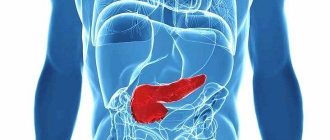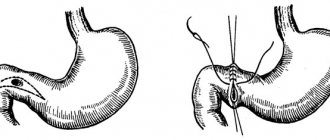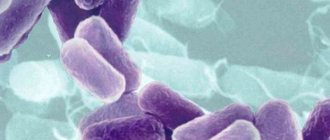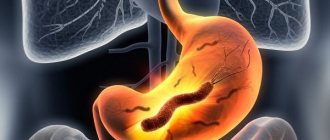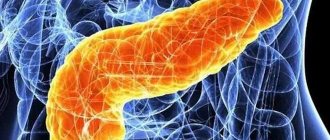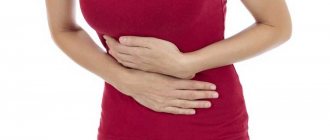Types of disease
Any form of pancreatitis is treatable if the pathology is diagnosed in a timely manner.
Considering the degree of development of the inflammatory process, the following types of disease are distinguished:
| Name | Description |
| Acute pancreatitis | It is characterized by sudden development in a mild or dangerous form, but passes after some time. There is a threat of irreversible changes in the tissues of the pancreas. People aged 30 to 60 years are at risk. |
| Chronic | The inflammatory process continues to progress, resulting in impaired pancreatic function. The main reason is poor diet and alcohol abuse. |
Primary chronic pancreatitis is characterized by damage to the pancreas. The secondary type of disease occurs as a result of dysfunction of the digestive system.
Diet for diseases of the pancreas
Diseases of the pancreas (symptoms are the first reason to start following a diet) most often begin due to poor nutrition. In case of acute disease, it is necessary to refuse food for up to 1 day. Only water or rosehip decoction is allowed. Next, the patient is transferred to a light menu.
The following products and prepared dishes are allowed for consumption:
- At first, pureed soups made from viscous cereals and vegetables are allowed;
- meat, fish and eggs can only be steamed;
- vegetables only in boiled form and crushed to puree;
- jelly, compotes and weakly brewed green tea;
- milk products;
- pasta;
- You can only eat wheat bread that is one day old.
Portions must be small, neither hot nor cold. It is advisable to eat at least 6 times during the day. It is recommended to chew food thoroughly to make it easier for the gastrointestinal tract to absorb food.
Excluded from the diet:
- fried and fatty foods, even boiled fatty meat;
- alcohol;
- sour dishes, as well as vegetables and fruits;
- spices, especially hot ones;
- salted, pickled and smoked products;
- canned foods and semi-finished products;
- sweet cakes and pastries;
- chocolate and sweets.
You should not eat foods high in fiber, as well as those that provoke an increase in gases and create a fermentation process in the intestines. In fresh form, after the acute phase of the disease, fresh foods and vegetables are excluded from the diet. It is possible only after heat treatment.
Stages and degrees
A gastroenterologist will help determine the area affected by the inflammatory process. The specialist will take into account the patient’s complaints and examination results. It is important to determine the degree and stage of development of pancreatitis in order to select the most effective treatment.
The disease goes through the following stages:
| Name | Description |
| Stage 1 | The pathology lasts 5-7 days. Pancreatic cells swell. An inflammatory process develops in the abdominal area. Decomposition products are absorbed by the body. Without timely treatment, pathological processes progress, the brain, heart, lungs are affected and the risk of death is high. |
| Stage 2 | The reactive period lasts a week. At stage 2, a clot of pancreatic infiltrate forms. Accompanying symptoms are fever, gastric ulcer and jaundice. |
| Stage 3 | Purulent complications appear, against which bleeding and sepsis occur (blood poisoning, leading to death). |
| Stage 4 | The recovery period lasts 3 weeks in most cases. Pathological foci of infiltrate resolve. The disease becomes chronic. |
Symptoms of pancreatitis in women depend on the stage of pathological processes, the extent of their spread and the area of damage to the pancreas. The first signs of the disease cannot be ignored, since progressive inflammation can be fatal.
Complication of the inflammatory process
In severe cases of pancreatitis, if adequate measures are not taken, complications may arise that will lead to severe damage to internal organs, and in some cases to death:
- pancreatogenic shock is a condition in which blood pressure drops sharply and heart rate increases, and the vital activity of all body systems decreases;
- peritonitis;
- bleeding in the stomach and other organs of the digestive system;
- pancreatic necrosis;
- hemorrhagic or macrofocal necrosis;
- liver and kidney damage;
- cerebral edema.
In severe cases of pancreatitis, if adequate measures are not taken, complications may arise that can lead to bleeding in the digestive organs.
Any of these complications can lead to irreversible consequences for the body if the patient does not receive medical care in a timely manner.
We recommend reading: Why does dryness and bitterness in the mouth appear and how to treat it?
Symptoms
Signs of pancreatitis in women will help the doctor establish an accurate diagnosis, determine the form, stage of the disease and the degree of development of pathological processes.
Symptoms of pancreatitis in women can be identified immediately.
| Name | Clinical picture |
| Acute pancreatitis |
|
| Chronic pancreatitis |
|
The acute form of pancreatitis in some situations entails internal bleeding, therefore it is life-threatening and requires serious medical care. Severe intoxication of the body provokes an increase in temperature, the appearance of a rash on the body in the abdominal area and a specific coating on the tongue. The skin becomes not only pale, but also yellow.
Oncologist and pancreatitis
Many patients, as soon as they see the name of the doctor in the direction, begin to panic. An initial consultation with an oncologist is scheduled in order to detect problems in time.
After all, pancreatitis, especially if medical care is not provided in a timely manner, can lead to tumor diseases.
Recommendations from Elena Malysheva in the special issue “Live Healthy!” on how to overcome pacreatitis using the healing effects of natural remedies.
In order to identify problems, the oncologist prescribes instrumental diagnostics, in particular: computed tomography, magnetic resonance imaging or ultrasound examination.
Now you know which doctors treat acute and chronic pancreatitis. Remember, as soon as the first signs of the disease appear, you must immediately consult a doctor, this will help to quickly identify the causes of the disease and prescribe the necessary treatment.
Also read on our website: Acute pancreatitis: symptoms and treatment at home
Reasons for appearance
A general practitioner, gastroenterologist or surgeon will help you establish an accurate diagnosis. It is important to establish the main cause of the development of pathological processes.
Pancreatitis in women is provoked by the following factors:
| Name | Description |
| Alcohol abuse | In most cases, alcohol is the main cause (50%) of the development of pancreatitis. Alcohol increases the concentration of enzymes and provokes a spasm of the sphincter, which is located between the pancreas and duodenum. After drinking alcoholic beverages, pancreatic juice accumulates in the pancreatic ducts, and this is how the inflammatory process begins. |
| Hormonal disturbances or changes | Menopause, pregnancy, use of contraceptives that contain hormones. |
| Poor nutrition, strict diet, fasting | Pancreatitis is provoked by fatty and spicy foods in the human diet. You cannot eat on an empty stomach while drinking alcohol. |
| Cholelithiasis | In 20% of cases, pancreatitis is a complication of this disease. A moving stone along the bile duct can block the exit from the pancreas, causing stagnation of enzymes. |
| Abdominal injury | Pathological processes provoke inflammatory diseases that affect any organ of the abdominal cavity. |
| Infectious lesion | The cause is viral hepatitis or influenza. |
Symptoms of pancreatitis in women also occur against the background of numerous provoking factors that increase the risk of developing pathological processes.
Scroll:
- diseases of the duodenum (ulcer, duodenitis);
- surgical treatment of the stomach or biliary tract;
- mechanical damage to the abdomen;
- taking medications;
- disturbance of material metabolism;
- infection with parasites (ascariasis);
- anatomical state of the pancreatic ducts;
- pathological vascular diseases.
The hereditary factor is also one of the reasons that increases the risk of developing pancreatitis in a woman.
Diagnostics
A timely medical examination will help identify the disease at an early stage of development and begin treatment selected by a therapist, gastroenterologist or surgeon. It is not recommended to take measures on your own, as it can cause serious complications.
The following methods are used to diagnose pancreatitis in women:
| Name | Description |
| Laboratory tests (blood, urine) | The activity of enzymes in the blood increases, which enter there against the background of the death of pancreatic cells. |
| Ultrasound examination of the pancreas (ultrasound) | The examination helps determine the size of the organ, contour and echogenicity indicators. |
| Abdominal x-ray | Diagnostics, with the help of which the doctor detects stones in the bile duct, intestinal obstruction. |
| Computed tomography (CT) | The examination allows you to identify foci of pancreatic tissue necrosis and assess the condition of fiber in the retroperitoneal region. Computed tomography allows you to see pathological changes in the abdominal or chest cavity. |
| Diagnostic laparoscopy | Examination involving surgical intervention. Doctors reliably study the condition of the abdominal organs. If necessary, a special drainage is installed or a full-fledged operation is carried out. |
Gastroscopy (EGD) will determine the extent of the spread of the inflammatory process to the digestive organs (stomach, duodenum). Additionally, tests are carried out after a glucose or drug load.
When to see a doctor
Symptoms of pancreatitis in women require not only consultation with a therapist or gastroenterologist, but also a full medical examination. It is important to immediately seek help when the first disturbances in the functioning of the pancreas appear.
Considering the patient’s condition, additional consultation with a nutritionist may be necessary to create the correct diet. The surgeon will also help determine how serious the situation is. You should not self-medicate, as this can worsen your health condition.
Prevention
It is possible to prevent not only the underlying disease, but also the exacerbation of pathological processes.
To do this, the gastroenterologist recommends adhering to the following rules:
- Completely eliminate alcoholic beverages and tobacco products from your life.
- Reduce the consumption of fried, fatty and spicy foods to a minimum.
- If you have pancreatitis, you should not drink sweet carbonated drinks.
- Moderate physical activity is acceptable.
- It is necessary to visit a gastroenterologist for preventive purposes.
- It is recommended to carry out sanatorium-resort treatment.
- Treat various infectious diseases in a timely manner.
- It is recommended to avoid stressful conditions and psycho-emotional stress.
Patients with pancreatitis should not work in enterprises where there is general and local vibration and heavy loads. The same applies to work that requires muscle tension and a forced certain body position. Activities that do not allow you to comply with the dietary regime are strictly prohibited.
With such a disease, economic, administrative, clerical or intellectual professions, where the amount of work is small, are more suitable. You may need to create special working conditions or work from home.
Symptoms of pancreatitis (Inflammation of the pancreas)
Symptoms of the disease are completely different for each person:
- A very severe girdling pain that subsides only with a certain position of the body. In most cases, this occurs when the person is sitting and the body is slightly tilted forward.
- Vomiting, followed by short-term relief.
- The stomach is tight.
- Increased sweating and weakness throughout the body.
- A sharp increase in temperature.
Possible complications
Symptoms of pancreatitis in women in the absence of medical care progress and intensify.
Without timely treatment or failure to comply with medical recommendations, the patient may face serious consequences:
| Name | Description |
| Cholecystitis | A complication of pancreatitis in women, which is characterized by an inflammatory process in the gallbladder area. |
| Duodenal stenosis | There is a narrowing of the duodenum. Food cannot move normally, which leads to debilitating frequent vomiting. |
| Cellulitis or abscess | Purulent lesion of the pancreas resulting from the addition of a secondary infection. |
| Pancreatic ascites | Appears against the background of a rupture of the pancreatic duct. A fistula forms in the abdominal or pleural cavity. |
| The flow of bile is impaired | A complication that often occurs against the background of chronic pancreatitis. Disruption of the outflow of bile occurs when the head of the pancreas is enlarged. An accompanying symptom is obstructive jaundice. |
In severe cases, pancreatitis provokes intra-abdominal bleeding and destruction of the pancreas, which leads to fatal peritonitis. Diabetes mellitus is also a complication of the disease. With the development of chronic pancreatitis in patients, the risk of developing malignant processes in the pancreas increases.
Necrosis of organ cells or blockage of its ducts leads to the formation of a cyst.
When the first symptoms of pancreatitis appear in women, it is recommended to immediately go to the hospital. Delayed treatment can lead to serious consequences. Treatment is carried out by a therapist, gastroenterologist or surgeon. Methods and means of therapy are selected based on the results obtained after a complete diagnosis.
